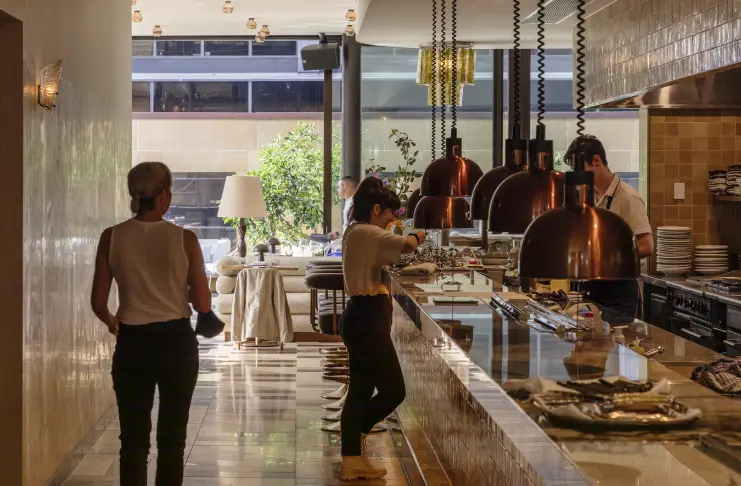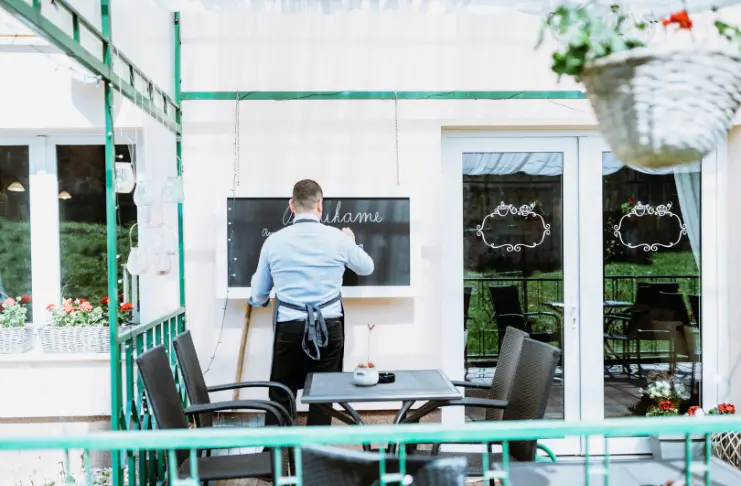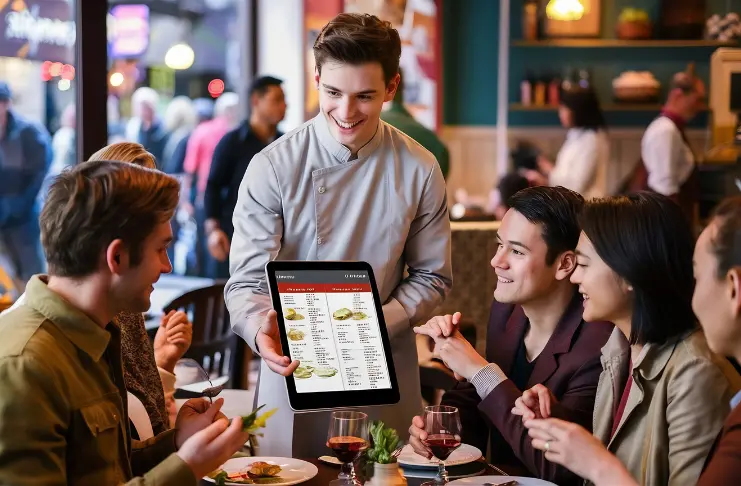
Europe’s restaurant industry is a complex landscape in 2025, with growth patterns varying significantly across different markets. Some countries are seeing steady gains, helped by tourism and stable consumer demand. Others are dealing with higher operating costs, tighter margins, and slower footfall.
Nevertheless, Europe’s foodservice market is expected to grow at a rate of 5% from 2026 to 2032, highlighting its strong growth potential. While big dining markets like France, Germany, and the UK retain the lion’s share of revenue, smaller economies in Eastern and Southern Europe are also enjoying faster year-over-year growth, offering new opportunities.
But what does this mean for the restaurant industry? And what can restaurant owners expect? This blog will uncover the major restaurant industry Europe statistics to help understand which countries are leading growth, what diners actually want, and how operations vary across regions.
How Big Is the Restaurant Market in Europe?
A. Total Market Size
The European foodservice market is projected to reach $950 billion in 2025, up from roughly $870 billion in 2024. This includes all food and beverage sales such as restaurants, cafés, bars, catering, and street food outlets. The forecast further estimates a jump to $1.51 trillion by 2030 at a CAGR of 9.6%, implying both scale and potential in the region.
B. Major Growth Drivers
Europe’s restaurant sector is evolving in response to both structural shifts and consumer-driven demand. Here are five key forces behind its sustained growth in 2025:
1. Demand for Convenience
Consumers across major markets are increasingly prioritizing speed and flexibility, which is growing demand for takeout, delivery, and grab-and-go dining. Urban professionals, in particular, are driving consistent growth in quick-service formats and mobile-based ordering.
2. Tourism Recovery
International and intra-European travel have picked up again, especially in markets like Spain, France, and Italy. This is bringing back volume to restaurants in major tourist destinations and reviving seasonal demand across Europe.
3. Diverse Cuisine Preferences
Travel, migration, and social media have made diners more open to ethnic and global cuisines. There’s a stronger demand for international flavors, fusion menus, and street-food-inspired concepts, particularly among younger audiences. This has prompted operators to introduce regionally diverse menus or fusion offerings to increase customer engagement across major cities.

4. Increased Tech Adoption
Restaurant tech, including contactless payments, digital reservations, and self-ordering kiosks, has become a core aspect of operations and consumer experience. With increased investment in integrated tech infrastructure, owners are able to make operations smoother and service faster, which is contributing to the growth of the European restaurant industry.
5. Conscious Consumption
More diners are choosing plant-based meals, asking about sourcing, and supporting restaurants that reduce food waste. As a result, operators aligned with eco-conscious values are benefiting from increased loyalty and stronger brand equity.
Restaurant Industry Europe: Statistics for Country-Specific Growth
Europe’s restaurant industry looks very different from one market to the next. Economic conditions, tourism recovery, consumer preferences, and the pace of digital adoption all vary by region. This section breaks down key market data and trends across individual countries and sub-regions to show where growth is happening and why.
A. United Kingdom
- The UK’s foodservice market was valued at $102.75 billion in 2024 and is projected to reach $152.48 billion by 2030, at a compound annual growth rate of 6.8%.
- Within the UK, 68% of consumers prefer contactless payment and digital ordering options at restaurants, indicating a shift to digital services in restaurants.
- According to the UK Office for National Statistics (ONS), spending on dining out returned to 95% of pre-pandemic levels, with 12.4% growth in 2022.
- Within the UK foodservice sector, quick service restaurants (QSRs) hold the largest market share by food services type, while cloud kitchens are the fastest-growing segment in 2025.
B. Germany
- Germany’s foodservice market is forecast at $139.43 billion in 2025, expanding at a CAGR of 6.08% to $187.31 billion by 2030.
- Full-service restaurants held the largest market share (40.1%) in 2022, but cloud kitchens are the fastest-growing segment at a CAGR of 6.37%.
- Germany recorded around 163 million tourist arrivals in 2022, which is influencing demand for diverse dining experiences.
C. France
- The French foodservice market reached $91.3 billion in 2024, with projections to $125.5 billion by 2033, representing a CAGR of 3.6%.
- The French restaurant industry is being driven by an increased focus on health, conscious eating, and digital ordering services.
- In 2023, France dominated the European food service market with an 18.2% market share.
D. Italy
- Italy’s foodservice market is estimated at $109.4 billion in 2025, with a forecast to $175.1 billion by 2030, growing at about 9.86% CAGR.
- Pizza holds the biggest market share of the Italian restaurant market with over 40,000 FSR and QSR establishments across the country.
- Cafés and bars dominate the Italian food service landscape, with bars and pubs making up over 74% of outlets. Cafés are 25% of the market, underlining Italy’s strong cafe culture.

How Dining Out is Changing Across Europe?
1. Changing Dining Formats
Quick-service restaurants (QSRs) now dominate the European dining scene, capturing over 50% of the market share in 2024. That’s a clear indication that fast, consistent, accessible dining has become the default for many consumers.
Despite this strong positioning, full-service restaurants are now the fastest-growing segment in Europe. Clearly, diners are seeking both convenience and experience, switching between formats depending on preference and need.
On one hand, urbanization and busier lifestyles are fueling QSR growth. Over 80% of Europeans now live in urban areas, meaning time and convenience heavily influence food decisions. On the other hand, FSRs gain traction as disposable income increases and demand for experiential dining rises.
2. Experiential and Social Dining is on the Rise
As dining out returns to pre-pandemic levels across Europe, it’s no longer just about convenience or necessity.
Today, consumers increasingly seek memorable, socially driven experiences. According to a 2024 survey, 74% of diners are more likely to return to a restaurant that offers a unique experience.
Younger demographics, in particular, are leading this shift. For Gen Z and millennials, dining out is a key social ritual. For this reason, restaurants offering communal seating, chef’s counters, or curated tasting menus are seeing higher dwell times and repeat visits.
3. Time‑of‑Day Patterns Are Shifting
Within Europe, more people are dining out, with meal occasions rising up 8.7% overall. Going deeper, breakfast is the fastest-growing meal occasion at 13.7%, as compared to dinner at 5.7%, pointing to a preference for early morning dining opportunities.
At the same time, meals are also being reshaped into lighter, more frequent formats. This presents a great opportunity for all-day café models, express lunch offerings, and extended service hours to catch evolving demand windows.
4. Healthy Dining
European diners are signaling that health and sustainability now influence where they choose to eat. A survey across six major markets found that 71% of European consumers say sustainability is important in choosing where to eat out, and 59% believe sustainable meals are healthier.
Across Europe, around 60% of consumers say they actively try to eat healthily, with younger demographics especially focused on ingredients, clean-label offerings, and dietary needs like lactose-free or vegetarian meals.
5. Speed and Convenience are Crucial
If there’s one thing consumers love at restaurants, it’s speedy and convenient service. This is probably why the delivery market is rapidly growing across Europe, with projected growth to $110.3 billion by 2030, at a CAGR of 7.25%.
In addition, 55% of Europeans order food delivery at least once a month, underscoring that digital convenience is now a major part of foodservice behavior. As a result, restaurant operators that invest in their digital ordering infrastructure, from restaurant apps to QR code ordering and self-service kiosks, stand to gain significantly from this shift.
EXPERT OPINION
CEO and founder of Beyond Gastronomy, Jan Scheidsteger, talks about understanding the guests and their needs for restaurant success. “When it comes to food delivery, we need to be conscious about how we will live in the next ten years to understand how restaurant businesses will adapt. I’d say there’s a growing need for snackification – going from one snack to the next to function. However, people are no longer necessarily working 9 to 5. They’re working flexibly, from home and the office, and food delivery will have to transform to meet consumers’ needs. In the future, quality will be even more crucial to set your (delivery) brand apart.” |
Preferences, Values, and Expectations of the European Diner
- In the UK, consumer spending in foodservice rose 10% year-over-year in 2024, and is expected to grow another 6% through the year, with visits rebounding by nearly 3%.
- Aggregators (like Just Eat, Deliveroo) accounted for 65% of Europe’s platform-to-consumer delivery market in 2024, while full-service models are catching up with a 9.1% CAGR through 2030.
- In Germany, breakfast occasion visits increased by 2% in 2024, reaching 2.6 billion foodservice breakfast events, driven notably by younger adults.
- Fast-food formats dominate in key markets, representing 70% of restaurants in the UK and 49% in Germany, underlining how strong convenience-driven models have become across Europe.
- About two-thirds of European consumers actively choose more vegetables and reduce meat, with up to 64% reporting increased veggie intake and 51% cutting back on meat.
- Consumers are placing more weight on naturalness, regionality, and organic sourcing, with 81% associating “organic” with “natural” and 59% wanting clear, simplified sustainability claims.
Major Technology Adoptions in European Restaurants

Restaurants across Europe are embracing technology to streamline operations, boost revenue, and serve guests better. Here are some key adoption areas in the industry:
1. Self-Service Kiosks
Kiosks are increasingly common in QSRs and fast-casual outlets, helping reduce queues and enhance order accuracy.
- The European self-service kiosk market generated $8.7 billion in revenue in 2024 and is projected to grow at a 10% CAGR through 2030, reaching around $15.1 billion.
- In major European markets like Germany, the UK, and France, self-service kiosks are installed in nearly 59% of restaurants, and Europe accounts for roughly 28% of the global kiosk market.
- France saw a 21% year-over-year increase in kiosk installations, while the UK’s fast-food chains deploying kiosks saw order value rise by 18%.
2. QR Code Ordering
QR code ordering systems reduce table service time by an average of 15 minutes, which can increase table turnover by up to 30%. As a result, restaurants across Europe are switching to QR code menus to benefit from enhanced operational efficiency.
- QR code ordering systems contributed approximately $770 million in revenue from Europe in 2024, representing 27% of the global QR ordering market.
- More than 70% of restaurants across the UK have integrated QR codes into their operations, and over 85% of those use them specifically for digital menus.
- Over 86% of UK smartphone users have scanned a QR code at least once, and 36.4% scan one at least weekly.
3. Cloud POS Systems
Modern restaurants across Europe are moving toward cloud-based POS platforms to simplify operations, scale efficiently, and integrate data across functions.
- The European restaurant POS software market is projected to grow from about $932 million in 2022 to $1.63 billion by 2030, at a 7.5% CAGR.
- More than 70% of European full-service restaurants and QSRs use a cloud-based POS system.
- The UK hospitality sector’s growing investment in digital solutions has led to a 50% increase in POS adoption.
Given a competitive restaurant landscape and high customer expectations, digital systems have become the operational backbone across entire restaurant ecosystems. From POS systems that simplify front-of-house operations to kiosks and mobile ordering that improve order accuracy and labor efficiency, the restaurant industry is investing in smarter tech for a better customer experience.
Conclusion
The European restaurant industry continues to expand, but the growth is highly fragmented. Markets across the continent are evolving at different speeds, shaped by local dining habits, economic pressures, and tech adoption.
So, when looking to scale or innovate in this space, success depends on understanding the key restaurant industry Europe statistics and acting with regional awareness.
Frequently Asked Questions
The restaurant and food service industry in Europe is growing at a CAGR of 9.6% and is expected to reach $1.51 trillion by 2030.
France has the highest number of restaurants in Europe, with over 177,000 establishments recorded in 2023.
As of 2024, the European food service industry is valued at $950 billion.
McDonald’s remains the largest fast-food chain in Europe, with over 2,000 locations across major countries like France, Germany, and the UK.








